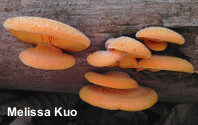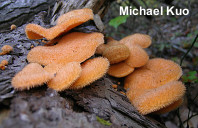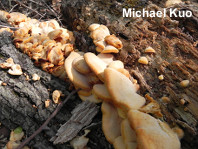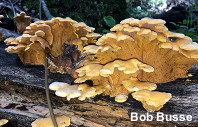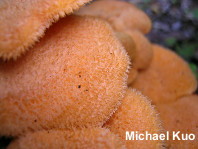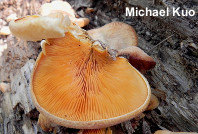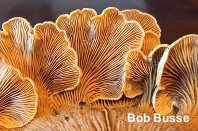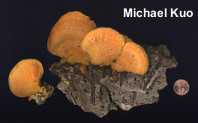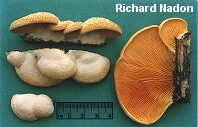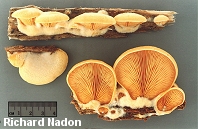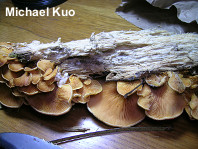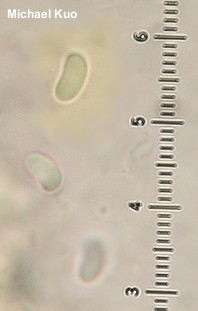| Major Groups > Gilled Mushrooms > Pink-Spored > Pleurotoid Mushrooms > Phyllotopsis nidulans |

|
Phyllotopsis nidulans [ Basidiomycota > Agaricales > Uncertain > Phyllotopsis . . . ] by Michael Kuo This beautiful but often stinky mushroom is orange from head to toe, and densely hairy on the cap surface. It grows in shelf-like clusters on the deadwood of hardwoods and conifers across North America. In fact, a "mating" study by Petersen & McCleneghan (1997) demonstrated that specimens of Phyllotopsis nidulans from Alaska to Costa Rica were The foul odor of Phyllotopsis nidulans is sometimes lacking, but fresh collections usually manage to work up a pretty good stink. Other identifying features include the lack of a well-developed stem, the tendency of the caps to fade to orangish yellow, and the slightly pink spore print. Mycology is still working on the question of where, precisely, to place Phyllotopsis nidulans in the fungal world. It has traditionally been placed in the Tricholomataceae, but DNA studies have not supported this idea. Most recently, Lodge and collaborators (2013) have informally placed Phyllotopsis nidulans in what they call "the basal Hygrophoroid clade," closely related to but separate from the hygrophoroid mushrooms, clustered with species of Tricholomopsis, Pleurocybella porrigens, and others. Description: Ecology: Saprobic on the deadwood of hardwoods and conifers--often those fairly recently dead, with bark still adnate; causing a white, stringy rot; growing gregariously or in overlapping clusters; fall and spring, or over winter in warm climates; widely distributed in North America. The illustrated and described collections are from Illinois, Kentucky, Arkansas, Québec, and California. Cap: 2–7 cm across at maturity; more or less fan-shaped or semicircular in outline; planoconvex; dry; prominently hairy, at least when young; sometimes with a whitish dusting at first, but soon bright orange, fading to yellowish orange or orangish yellow; the margin inrolled when young, and sometimes bruising brownish when handled. Gills: Close or nearly crowded; thin; short-gills frequent; bright to pale orange. Stem: Absent or very poorly developed and lateral. Caps sometimes appear to share a poorly defined "base." Occasionally gills develop on the substrate below the cap, appearing almost resupinate. Flesh: Pale orange; soft; not changing when sliced. Odor and Taste: Taste mild or foul; odor strong and foul, reminiscent of skunk cabbage--or in some collections not distinctive. Chemical Reactions: KOH negative on cap surface, flesh, and gills. Spore Print: Very pale pink (often appearing white unless viewed against a pure white background). Microscopic Features: Spores 4.5–6 x 1.5–2.5 µm; allantoid; smooth; hyaline in KOH; inamyloid. Hymenial cystidia not found. Pileipellis a tangled cutis; elements about 2.5 µ wide, smooth, hyaline, clamped at septa; hairs composed of elements 5–10 µm wide, frequently septate, smooth, orangish in KOH, with cylindric to fusiform terminal cells. REFERENCES: (Persoon, 1798) Singer, 1936. (Fries, 1821; Saccardo, 1887; Smith, 1975; Smith, Smith & Weber, 1979; Arora, 1986; States, 1990; Breitenbach & Kränzlin, 1991; Phillips, 1991/2005; Lincoff, 1992; Metzler & Metzler, 1992; Horn, Kay & Abel, 1993; Barron, 1999; Roody, 2003; McNeil, 2006; Miller & Miller, 2006; Binion et al., 2008; Kuo & Methven, 2010; Lodge et al., 2013; Kuo & Methven, 2014; Desjardin, Wood & Stevens, 2015; Evenson, 2015; Siegel & Schwarz, 2016.) Herb. Kuo 10160409, 10310404, 04131103, 01301701. Thanks to Bob Busse for collecting, documenting, and preserving some of the illustrated and described specimens. This site contains no information about the edibility or toxicity of mushrooms. |
© MushroomExpert.Com |
|
Cite this page as: Kuo, M. (2017, May). Phyllotopsis nidulans. Retrieved from the MushroomExpert.Com Web site: http://www.mushroomexpert.com/phyllotopsis_nidulans.html |
